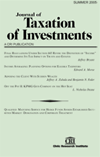The Pursuit of Dividends After the Tax Act of 2003: Limitations, Traps and Ambiguities
Author: Robert Gordon.; Mark Fichtenbaum.
Source: Volume 21, Number 01, Fall 2003 , pp.128-132(5)

< previous article |return to table of contents
Abstract:
The Jobs and Growth Tax Relief Reconciliation Act of 2003, PL 108-27, reduced the rate of tax on both long-term capital gains and dividend income earned by individuals to a maximum rate of 15%. Though it makes long-term gains more interesting, that in itself probably will not change many people’s investment behavior. The change in the rate of dividend taxation (more than a 50% decrease) should change the investment behavior of individual investors. However, certain limitations that investors must be wary of were also imposed in order to obtain the lower rate. These limitations mirror in many ways Section 246, which governs corporations wanting to utilize the dividends received deduction. This article will focus on some of the limitations and traps that investors will have to deal with under the new law, as well as discuss some of the ambiguities still left unanswered.Keywords:
Affiliations:
1: Twenty-First Securities Corporation; 2: Twenty-First Securities Corporation.